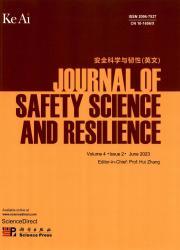工业基础设施对多种灾害脆弱性的多尺度表征
IF 3.4
Q1 PUBLIC, ENVIRONMENTAL & OCCUPATIONAL HEALTH
引用次数: 0
摘要
欧盟委员会的2022/2557号指令旨在通过与现有的欧洲立法相结合来增强欧洲关键实体的弹性,但它缺乏关于解决脆弱性的明确指导。具体来说,主要危害行业(MHIs)是面临自然灾害和技术灾害(NaTech事件)相互作用所产生的独特风险的关键基础设施;然而,现有的政策经常忽视了加工工厂对这些复杂现象的潜在脆弱性。本研究的目的是系统地描述工业关键基础设施(ici)在其领土内对各种危害的脆弱性。在意大利的背景下实施了一个多尺度程序作为案例研究,其中使用开放数据开发了空间分析。从意大利国家清单开始,MHIs集中在工业宏观部门,并按地区代表全国,将其分布与感兴趣的气象或地球物理数据联系起来。在区域尺度上,山前地区的mhi被表示为准时元素,以省为单位将潜在破坏区内的人口联系起来。在市政规模上,先前经过验证的多灾害脆弱性评估工具随后被量身定制,以缩小规模,适用于工业环境中的特定应用。这种适应性考虑了充满活力的关键基础设施与周围各种危险之间的双向相互作用,提供了一个空间脆弱性概况,可以补充工业事故情景的概率分析。综上所述,该框架可以提高从运营商到主管部门等工业事故控制决策链中各个层面和不同利益相关者的意识。本文章由计算机程序翻译,如有差异,请以英文原文为准。
Multi-scale characterization of industrial infrastructure vulnerability to multiple hazards in their territories
Directive 2022/2557 from the European Commission aims to enhance the resilience of critical entities in Europe by integrating with existing European legislation, but it lacks explicit guidance on addressing vulnerabilities. Specifically, major hazard industries (MHIs) are critical infrastructures that face unique risks arising from the interactions of natural and technological hazards (NaTech events); nevertheless, existing policies frequently overlook the potential vulnerabilities of process plants to these complex phenomena. The goal of this research was to systematically characterize the vulnerability of industrial critical infrastructures (ICIs) to various hazards in their territories. A multi-scale procedure was implemented in the Italian context as a case study, where spatial analyses were developed using open data. Starting from the Italian national inventory, the MHIs were clustered in industrial macro-sectors and represented nationally by regions, relating their distribution to meteorological or geophysical data of interest. At the regional scale, the MHIs of the Piedmont Region were represented as punctual elements, associating the population within potential damage zones by province. At the municipal scale, a previously validated multi-hazard tool for vulnerability assessment was then tailored to a reduced scale for specific applications in an industrial context. This adaptation, which considers the two-way interaction between an energetic critical infrastructure and various hazards in its surroundings, delivers a spatial vulnerability profile that may complement the probabilistic analysis of industrial incidental scenarios. In summary, this framework may raise the stakeholders awareness at various levels and with different interests within the industrial accident control decision-making chain, from operators to competent authorities.
求助全文
通过发布文献求助,成功后即可免费获取论文全文。
去求助
来源期刊

安全科学与韧性(英文)
Management Science and Operations Research, Safety, Risk, Reliability and Quality, Safety Research
CiteScore
8.70
自引率
0.00%
发文量
0
审稿时长
72 days
 求助内容:
求助内容: 应助结果提醒方式:
应助结果提醒方式:


